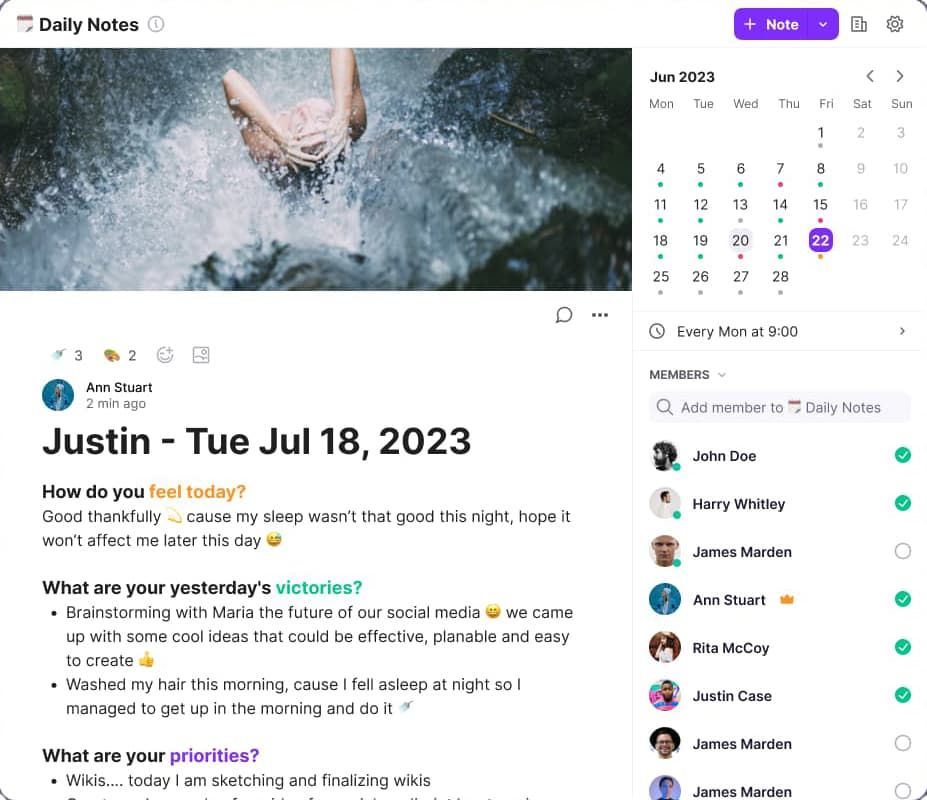

How to Get Used to Virtual Standup Meetings in Remote Teams
Remote work is officially the most sought-after employee privilege in the post-Covid world. If you can believe it, 65% of workers want to work remotely all the time. Not having to dress up, put on a brave face, and put up with city traffic is people’s favorite part of their job.
From the employer's perspective, remote workers make more financial sense. They earn more money but spend fewer company resources. What a win-win for all!
But is it really that simple? Of course not. Remote workers still feel lonely, neglected, and burnt out from communication tools. The thing that can help bridge the distance is a good old team meeting. Standup meetings are perfect for this, and they keep the efficiency up.
The importance of remote standups between the virtual team
In case you haven’t heard of it, what is a stand-up meeting?
In scrum and agile work models, standup meetings are brief daily team meetings designed to keep everyone on the same page. The main purpose of these daily updates is to discuss progress and identify blockers. A typical standup meeting should last around 10–20 minutes.
Ideally, a 10-minute meeting should answer three critical questions:
- What did I work on yesterday?
- What am I working on today?
- What issues are blocking me?
Daily standups can help accomplish another key goal – straighten the team and boost collaboration. It’s specifically this that makes remote standups crucial for virtual teams. A focused discussion about everyone’s accomplishments and roadblocks is a great way to keep remote workers involved and on par with the in-house team without jeopardizing anyone’s efficiency.
The benefits of virtual standups
Timezone differences, social isolation, and communication breakdown are bad for business. Yet, these (and other) challenges come with the job description. If you’re running a remote company, you know a little bit about what we’re talking about – and you need a solution.
Adding a virtual standup meeting to a daily schedule can make a huge difference. If you’re not a big fan of meetings, you should still take a look at the benefits of virtual standups.
- Standup meetings save everyone’s time
Many teams suffer productivity loss because they don’t have a clear meeting agenda. Daily standup meetings are different. Every morning, the team has a succinct meeting to review current tasks and share status updates. That way, they can stay fully committed to work throughout the day and never lose sight of what their teammates are trying to accomplish.
- Remote standups help resolve blockers
One of the common issues that remote teams have is not being able to report everyday problems before they cause significant productivity loss. Luckily, immediacy is one of the most significant benefits of virtual daily standups: new and ongoing issues are being addressed daily.
- Daily standup meetings track progress
What happened with Nick’s tasks yesterday? Will Kate be able to complete the task board today? How many tasks behind the schedule are we? Answers to crucial questions like these can get lost due to the lack of communication between remote and in-house teams, but daily standups help put the pieces together. Daily exchanges are crucial for tracking both individual and team progress.
- Remote meetings boost team cohesion
Remote standups provide a communication platform where everyone can share critical updates, voice concerns, and express their individual perspective. When every employee is involved and encouraged to talk, the team feels more cohesive and ready to tackle any challenge.
- Daily standups improve collaboration
Speaking of team cohesion, daily standups are also an excellent way for teammates to practice and improve collaboration. Compassion and camaraderie are difficult to nurture in remote professional relationships, but virtual daily standups can change that. They give co-located teams an opportunity to hear all about their colleagues’ struggles and vice versa, which improves team bonding.
- Regular standups promote transparency
Task dependencies are among the biggest organizational and collaborative challenges faced by larger teams. They require near-perfect efficiency and impeccable communication but also complete transparency. All of that can be accomplished with regular daily standups for remote teams.
Challenges in virtual standup meetings
An effective stand-up meeting can improve teamwork and save time in the process. Still, even the best agile techniques like this one aren’t without their challenges. As a meeting leader and scrum master, you might get insight into team morale, but you might also wear your team thin.
Some of the worst common mistakes you can make if you’re not careful are:
- Picking the wrong time for a remote standup meeting
If you schedule a remote standup meeting for 10 AM, and work hours in your virtual office start at 9 AM, it’s doubtful that anyone will start working on important tasks for the day before the meeting. Your team is losing an hour of work for a 10-minute meeting. That's not ideal.
- Scheduling standups during off-peak productivity hours
A daily stand-up must be quick but productive, so choose your meeting time carefully. The worst you can do is schedule a remote daily standup early in the morning when everyone is still sleepy or later in the day when the team is tired and can’t wait to go offline.
- Choosing the same time slot for different time zones
If your remote team is scattered across different time zones, some of them will have to attend a morning standup at odd hours. Not only is it illegal to schedule meetings after work without compensation, but it’s also detrimental to their productivity and can cause serious burnout.
Remote standup best practices
So, what’s the best way to run a remote standup, then? Here are the best practices for turning your daily meeting routine into a team bonding event without wasting time or limiting efficiency.
🛠️ Choosing the right tool for remote standups
Remote work tools are a crucial form of communication for remote and hybrid teams. When choosing the best one for your needs, look for a collaborative platform that allows you to hold an entire meeting across time zones and has the necessary features for meeting via laptop.
One of the best examples of daily standup tools is Ayanza. In addition to task boards and key project management tools, it also includes instant messaging tools, a video conferencing tool, and templates with typical questions that serve as a stand up meeting agenda.

📅 Set a regular schedule for virtual standups
We’ve already discussed when not to schedule a stand-up meeting for a remote team, so let’s talk about what time is right for bringing everyone together in the same place. Before anything else, you must decide what’s better for you – synchronous or asynchronous meetings.
Unlike a synchronous stand-up meeting, which is always held at the same time and requires everyone to join in, asynchronous stand-up meetings allow scattered team participation. Every meeting attendee answers the same standup questions and shares updates daily but in their own time.
Asynchronous standups might be a better option for larger teams with employees worldwide, while smaller units, such as scrum teams, should commit to synchronous standup meetings. In either case, look for daily standup tools that offer both options, like Ayanza.
📋 Choose the right daily standup template
Daily standups are about wasting the least amount of time possible. Not having to prepare a separate daily stand up meeting agenda for every meeting is a huge time saver. That’s why Ayanza offers daily standup meeting templates with common questions tailored to your needs.
How do you choose the right template for your team? Obviously, you need to pick a template based on the type of team you’re leading, but you also need to consider your team’s preferred communication style. Ayanza has templates for agile teams, software teams, HR teams, and more.
👩💼👨💼 Lead by example as a leader
Whether you’re a scrum master or merely a meeting assistant, it’s your responsibility to lead by example. It’s especially important if you choose the asynchronous daily standup meeting model. If you make scrum questions your priority and one of the first daily tasks, others will follow suit.
🚀 Increase the engagement of remote daily standups
There are other ways to increase engagement and promote active participation during remote daily standups. Here are a few ideas that Ayanza teams use to boost contribution.
🌐 Become the virtual standup leader of your organization
In Ayanza, you can see a dashboard rating based on the number of filled-up entries for virtual standup meetings during that week. You can use this feature as a gamification tool. If you crown a weekly virtual standup leader based on this rating, you might motivate others to step up.
💬 Enrich remote standups by sharing personal news
Standups are supposed to be quick, but that doesn’t mean you can’t enrich them with important personal news. If Kate had a baby, invite her to share a picture. If one of the clients had kind words for Nick, make a career-win story out of that. It will help your team bond.
🙋♂️ Add interactive elements on virtual daily standups
Asynchronous communication allows a few things that in-person communication doesn’t. For example, on platforms like Ayanza, you can comment on your colleagues’ entries with emojis and gifs. Elements like these help promote interaction and ultimately boost team cohesion.
⏰ Hints to fill out virtual standup during the day (reminders)
If some of your team members forget to answer your fun team-bonding questions, Ayanza will remind them to do so. Sometimes, people get caught up in work, as they should. It’s not a bad idea to respect their peak hours and have Ayanza notify them later in the day.
📝 Create tasks from your remote daily standup notes
One of Ayanza’s smartest features is the ability to take notes during virtual standup meetings and turn them into tasks that you can start working on after the meeting, tracking their progress in the future. It’s a valuable tool in terms of efficiency, and everyone can use it.
Conclusion
Remote work has so many advantages, so why not make it work? Virtual standup meetings are among the best ways to improve and nurture a distributed team. Getting used to prescheduled daily meetings could take a while, but it’s easier if you have the right collaboration tools.
Daily standup tools like Ayanza can provide a fully-equipped meeting room next door to your project management kit. With daily standup templates to keep you concise and a stream of updates that everyone can join, you’ll get used to daily standups in virtually no time.
FAQ
Who should
participate in
remote standups?
Ideally, the entire team should participate in a standup meeting. However, if you have a large team where different people are working on different projects, and you are short on time, you can schedule a standup meeting to discuss a particular project and invite only the team members involved.
For example, if you’re leading a scrum team, your typical daily scrums should include you as the scrum master, relevant development teams, product managers, and product owners.
What is the
purpose of
virtual standups?
The primary purpose of virtual standups is to provide a brief, structured, and efficient way for team members to share regular updates, discuss progress, and address blockers. If you hold them on a daily basis , these meetings help foster communication, collaboration, and accountability, which is of particular importance in a remote setting.
Are there specific
tools for conducting daily standups for remote teams
?
Some of the regular tools used by large, distributed, and fully remote teams have special features for virtual standup meetings. Collaboration platforms suitable for conducting daily standup meetings for remote teams have instant messaging and video conferencing tools and more specific features such as daily standup templates.
What
information should be shared
during a virtual standup meeting?
Virtual standup meetings create a dedicated space for sharing updates on completed and ongoing tasks, roadblocks that might be hindering progress, and the next steps that need to be taken for the team to achieve daily or long-term goals.
It’s also an opportunity for the team members to coordinate their tasks, allocate resources, and share ideas, insights, and announcements that the rest of the team should be aware of.

